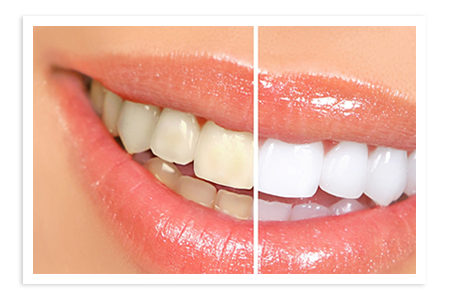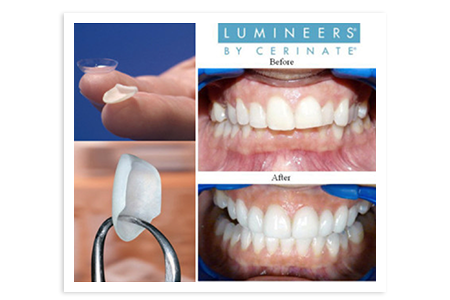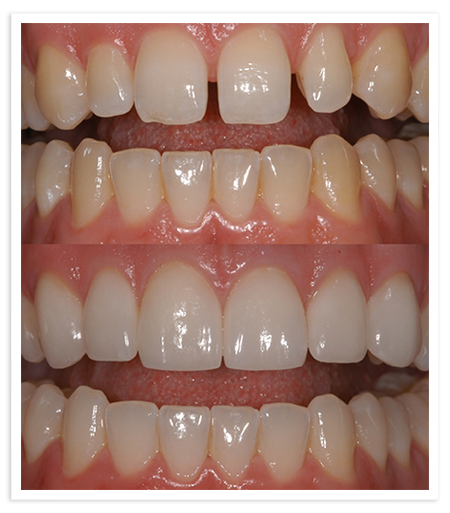Teeth stains are inevitable due to our consumption of a variety of foods and drinks (soda, spicy food, coffee, etc.). However, advanced teeth whitening technology has enabled dentists to whiten teeth without adversely affecting the tooth structure.
Almost all whitening methods are similar in concept, but some are much more effective because of the way the whitening material is delivered to the teeth. Another contributing factor is the concentration of the material, which is why less potent over-the-counter whitening systems usually dont give patients the results they are hoping for.

The two main methods of professional whitening are tray whitening and in-office whitening. In tray whitening, an impression is taken and a custom tray is made for the patient. Then, a supply of whitening gel is given to the patient and he/she wears the tray for a few hours each day (techniques differ) for a period of time until an acceptable result is achieved. Sensitivity of the teeth is a normal side-effect of this whitening method and is almost always transitional.
On the other hand, in-office whitening is the most efficient means of whitening. There are a number of different types used, but the process is very similar for these methods; you can have your teeth whitened in one session and achieve significant results. Your dentist can give you more detailed information and help you decide which method is more suitable for you and your teeth.
LUMINEERS® are an excellent option for people who are unhappy with the cosmetic appearance of their teeth. These ultra-thin porcelain slips fit perfectly over the teeth making them look cosmetically perfect, white and completely beautiful. An off-white or crooked smile can cause serious confidence problems. LUMINEERS® are a fantastic alternative for patients wanting a beautiful smile without surgery, harsh chemicals or painful treatments.
For LUMINEERS® to be applied, the underlying teeth, bone and gums must be healthy. Patients with gum disease or tooth decay must be treated prior to LUMINEERS® placement. Unlike dental veneers, LUMINEERS® can be left in place for over 20 years or removed upon request to expose the intact original teeth. LUMINEERS® can be fitted in just two appointments, and instantly add pizzazz to the smile.

Here are some of the problems that LUMINEERS® can solve:
LUMINEERS® provide a wide range of advantages over similar treatments. The most meaningful advantage to anxious patients is that no painful alterations of the teeth are required prior to the LUMINEERS® application. The covers themselves are so thin and unobtrusive that speech and eating are seldom affected.
Here are some of the other advantages of LUMINEERS®:
LUMINEERS® are constructed from Cerinate® porcelain, which is known for its exceptional strength. Even though LUMINEERS® are thinner than dental veneers, they are less likely to break or chip. Additionally, Cerinate® porcelain can be color-modified and balanced. This means that different levels of opaqueness and translucency can be utilized.
One of the main reasons LUMINEERS® are so easy to fit is that little etching has to be done beforehand. With veneers, many teeth might have to be permanently altered or drilled to ensure the best fit. However, LUMINEERS® offer a beautiful end product without any drilling, anesthesia or extensive etching. This factor alone can reduce the time in the dental chair by almost half, when compared to traditional veneers.
During the initial visit, bite impressions and X-rays are taken to determine the exact way the teeth fit together. The dentist also thoroughly examines the teeth to ensure that no tooth decay and no signs of gum disease are present. Together, the dentist and patient choose the color of the LUMINEERS® and the desired level of transparency. The bite impressions are sent to the laboratory to be custom-crafted.
The LUMINEERS® are bonded to the teeth at the second appointment. If bonding substance has oozed out from beneath the LUMINEERS®, this is carefully removed using a beveled featheredge margin. Once the LUMINEERS® are in place, the dentist polishes them until they are completely smooth. The advantage of this smoothness is that bacteria and staining agents cannot easily adhere to the surface of the LUMINEERS®.
The LUMINEERS® are finally separated. Up until this point, they are still attached where the bite impressions suggest teeth would naturally join. The treatment is finished, leaving a beautiful white smile, and perfect, healthy teeth.
If you have questions or concerns about LUMINEERS®, please ask your dentist.
Veneers are very thin pieces of durable, tooth shaped porcelain that are custom made (for shape and color) by a professional dental laboratory. They are bonded onto the front of teeth to create a beautiful and attractive smile.
Veneers can completely reshape your teeth and smile. They can often be alternatives to crowns and the ideal solution in treating many dental conditions.
As with most dental restorations, veneers are not permanent and may someday need replacement. They are very durable and will last many years, giving you a beautiful long lasting smile.
Reasons for porcelain veneers:

Getting veneers usually requires two visits to complete the process, with little or no anesthesia required during the procedure. The teeth are prepared by lightly buffing and shaping the surface to allow for the thickness of the veneer. A mold or impression of the teeth is taken and a shade (color) will then be chosen by you and the dentist.
On the second visit the teeth will be cleansed with special liquids to achieve a durable bond. Bonding cement is then placed between the tooth and veneer and a special light beam is used to harden and set the bond.
You will receive care instructions for veneers. Proper brushing, flossing and regular dental visits will aid in the life of your new veneers.